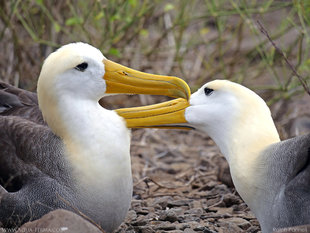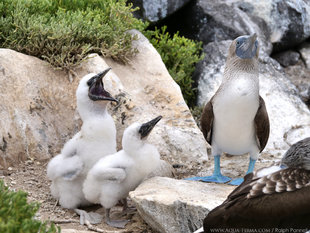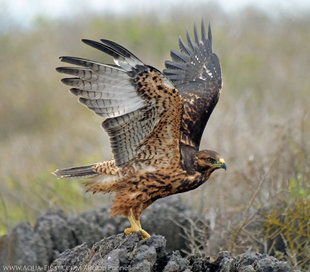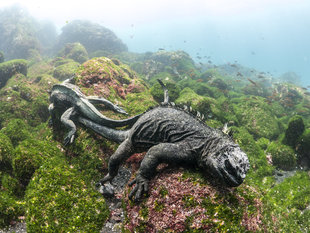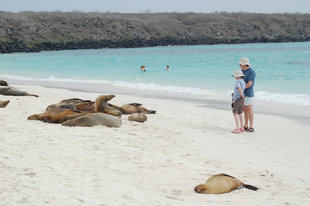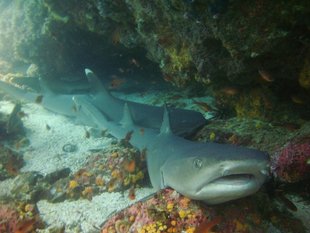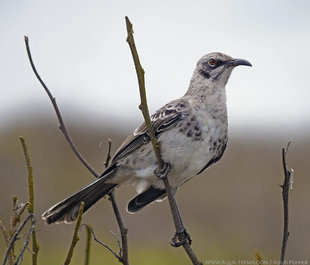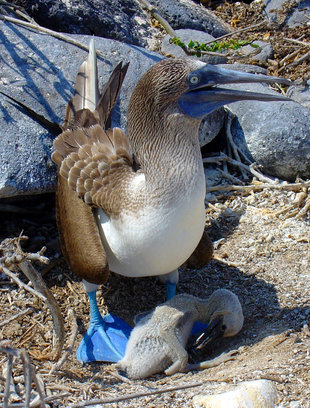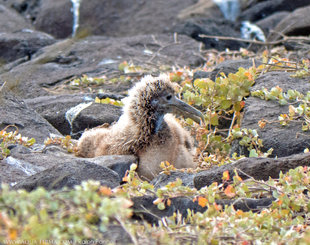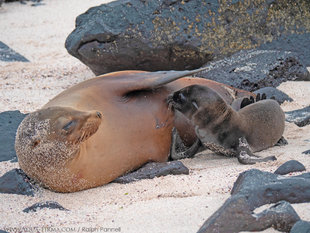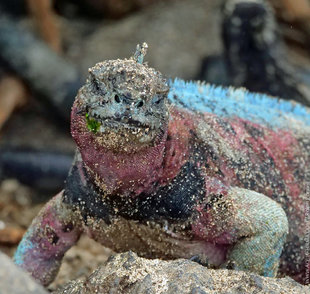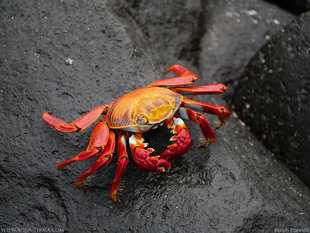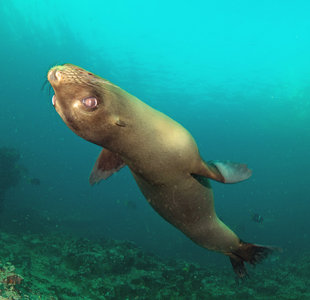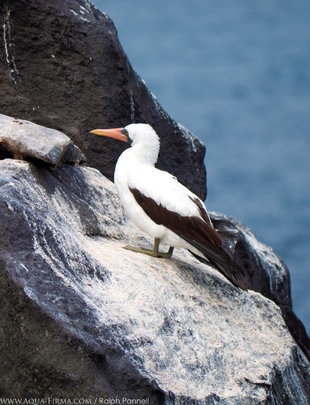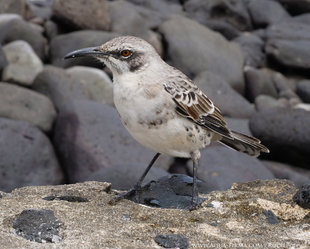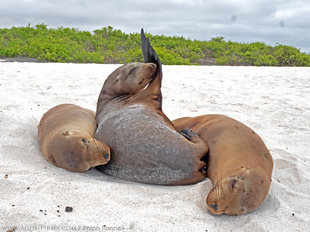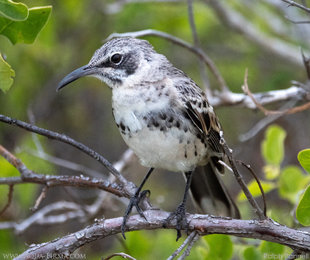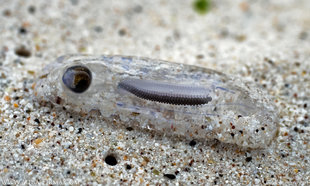Area Size: 60 Km²
Maximum Altitude: 206 meters
Island Highlights: Punta Suarez, Gardner Bay, Waved Albatross, Mockingbird, Lava Lizard, Marine Iguana, Giant Tortoise
Introduction
Española is situated at the extreme southeast of the Galapagos archipelago. Together with Santa Fé Island, Española is the oldest of the Galapagos Islands, at approximately 4 million years old.
The two significant areas of interest which exist on Española are that of Punta Suarez, considered to be the most attractive site of the Galapagos; and Gardner Bay, the location of a beautiful 1 km white sandy beach. Aside from being famed on their natural beauty, both of these sites provide great opportunities to discover fascinating and varied wildlife and marine life.
Aqua-Firma explores Española by means of our Wildlife Yacht Safaris and day trips from San Cristobal island.
Wildlife
In terms of wildlife habitats, the most prominent vegetation that is found on Española includes acacia, palo verde, saltbush, scrub vegetation, dense vegetation and thorny bushes.
One of Española's most renowned visitors is the Waved Albatross, which can usually be spotted resting in the trees set back from the cliff. Almost all of the World's 12,000 - 13,000 pairs come to this island to breed between April and December each year; with the exception being a small proportion that occasionally nests elsewhere on the continental part of Ecuador.
It is often possible to witness the albatross' courting ritual, reminiscent of a fencing match, but instead performed with their great yellow beaks and necks.
Marine Life
The brightly coloured marine iguanas which can be found on Española are fascinating sight to witness. They are the only 'sea-going' iguanas in the world, and as such they are renowned for their arbitrary 'spitting' ritual. Following a journey into the ocean to feed off the green algae, and by way of excreting the salt from the seawater from their bodies, the iguanas expel a gush of water through their nasal passage into the air. This spitting performance is reminiscent of a wet sneeze and is usually done while the iguana is resting.
This need to control their body temperature is part of the marine iguana's strict daily routine. Charles Darwin named these iguanas as 'imps of darkness', with their dark colour enabling them to absorb the maximum amount of heat from the sun's rays. Spending their nights grouped together or sheltering in the cracks of the congealed lava flows to contain their body heat, the rising of the morning sun always brings about their emergence onto the rocks. This daily emergence is a dangerous time. The iguanas move slowly so as to conserve as much energy as possible, leaving them vulnerable to attack by a Galapagos Hawk. Once surfaced, the iguanas spend their day stretched out and sunbathing to reach their (and coincidently ours too) optimum body temperature of 37°C.
Gardner Bay presents a wealth of remarkable marine life, making it a fantastic location for both snorkelling and diving, with Tortuga Rock as the favoured location. It is a good spot for opportunities to find white-tipped reef sharks, which can often be seen napping on the seabed. Hammerhead sharks are also sometimes found in these waters, whilst encounters with playful young sea lions are commonplace.
Other marine life that one can expect to encounter at Gardner Bay include schools of large tropical fish, such as yellow tailed surgeonfish, king angelfish and bump-head parrot fish.
The endemic marine iguanas, lava lizards and giant tortoises are also of substantial interest on Española island, all of which have been repatriated as result of the breeding program carried out by the CDRS (Charles Darwin Research Station) and the GNP (Galapagos National Park).
Conservation Issues
In the 1970, the Española giant tortoise population had dropped to only 15 on the island, as a direct result of hunting by hungry passing sailors. Following a pioneering project carried out by the Charles Darwin Research Station to repatriate giant tortoise hatchlings, there is now estimated to be a thriving, reproducing population of around 1,500.
Ultimately the project aims to turn the clock back to before human beings all but wiped out a species that helped to inspire Charles Darwin's theories on evolution and natural selection. The project has also bolstered plans to "re-tortoise" another Galapagos island, Pinta, in the hope of creating a pre-human balanced ecosystem.
Innovative projects such as this are one of the fundamental reasons why we at Aqua-Firma support the Charles Darwin Station and the Galapagos Conservation Trust with every client we send to the archipelago. We fully understand the need to protect such fascinating species and to encourage population growth of some of the Galapagos's most treasured wildlife and marine life.
Geology
Española is a relatively flat island with only a few hills. She is believed to be one of the islands whose lavas were extruded beneath the sea and later uplifted to form the island. Geologists have since found evidence of volcanic activity which occurred after the uplift.
There is no fresh water source on the island, making it uninhabitable for humans, however, there is a wealth of endemic wildlife, which contributes to making Española one of the most popular islands for visitors.
Gardner Bay is the location of a beautiful 1 km white sandy beach, considered to be the best in the Galapagos. Here, one can expect to be greeted by curious Española mockingbirds, whilst colonies of sea lions laze in the sun and sea turtles swim through the tide.
Punta Suarez is not only one of the most beautiful sites in the Galapagos, but it boasts the highest levels of endemism. A 2 km nature trail presents an array of birdlife, winding its way through colonies of blue footed and masked boobies, before eventually reaching the famous 'Blowhole'. The Blowhole blasts a geyser of ocean water some 20 m into the air and is best seen in the morning at high tide.

